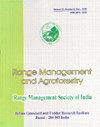Influence of detopping practices on green fodder availability, seed yield and economics of fodder maize (Zea mays L.) in central and southern Zea maysplateau regions of India
IF 0.8
4区 农林科学
Q3 AGRONOMY
引用次数: 0
Abstract
The unavailability of adequate quality seeds and green fodder during the lean period together affects livestock productivity in the country. Hence, it is necessary to assure the availability of quality seeds for sowing and green fodder to feed the livestock. To study this, field experiments were conducted on fodder maize at two locations in the country. Treatments included four detopping (DT) practices ., T : no DT, T : DT at 10 days viz12after (DA) 50% silking, T : DT at 20 DA 50% silking and T : DT at 30 DA 50% silking. Results demonstrated that 34DT at 10, and 20 DA 50% silking is not advisable in fodder maize for seed production as it considerably reduced the biomass accumulation (252.4-254.5 g/plant) and leaf relative water content (44.79-63.95%). However, no DT produced the highest growth attributes and green fodder yield followed by DT at 30 DA 50% silking which was at par with no DT regarding 100 seed weight (23.01 g) and seed yield (2725 kg/ha) with an additional green fodder yield (3245 kg/ha). Thus, no DT followed by DT at 30 DA 50% silking favored the economics of fodder maize seed production (gross return, net return, and benefit-cost ratio). Regarding locations, Dharwad (Karnataka) outperformed Jhansi (Uttar Pradesh) regarding growth, seed yield attributes, and the economics of fodder maize. Therefore, DT at 30 DA 50% silking could supply additional green fodder (3245 kg/ha) with a 14% compromise in the seed yield of fodder maize在印度中部和南部玉米高原地区,去梗方法对饲料玉米(Zea mays L.)的青饲料利用率、种子产量和经济性的影响
歉收期无法获得充足的优质种子和青饲料会共同影响该国的畜牧业生产率。因此,有必要确保播种用的优质种子和喂养牲畜的青饲料的供应。为了研究这个问题,在该国的两个地点对饲料玉米进行了实地试验。处理包括四种脱粒(DT)方法:T:不脱粒;T:在 50%丝期后 10 天(DA)脱粒;T:在 50%丝期后 20 天(DA)脱粒;T:在 50%丝期后 30 天(DA)脱粒。结果表明,在 10 天和 20 天 50%丝期施用 34DT 对饲料玉米的种子生产并不可取,因为它大大降低了生物量积累(252.4-254.5 克/株)和叶片相对含水量(44.79-63.95%)。然而,无 DT 产生的生长属性和青饲料产量最高,其次是 30 DA 50%丝期的 DT,在 100 粒种子重量(23.01 克)和种子产量(2725 千克/公顷)方面与无 DT 相当,但青饲料产量增加了(3245 千克/公顷)。因此,在 30 DA 50%丝期进行无 DT 后进行 DT 有利于饲料玉米种子生产的经济效益(毛收益、净收益和效益成本比)。就地点而言,达尔瓦德(卡纳塔克邦)在生长、种子产量属性和饲料玉米的经济性方面优于詹西(北方邦)。因此,30 DA 50%丝期的 DT 可提供额外的青饲料(3245 千克/公顷),饲料玉米种子产量减少 14%。
本文章由计算机程序翻译,如有差异,请以英文原文为准。
求助全文
约1分钟内获得全文
求助全文
来源期刊

Range Management and Agroforestry
AGRONOMY-
CiteScore
1.50
自引率
62.50%
发文量
25
审稿时长
>12 weeks
期刊介绍:
The Society has been established with the following objectives:
1. To advance the cause of research activity in all aspects of rangelands and to encourage and promote the studies on rangeland, wasteland ecosystems and agroforestry.
2. To provide facilities for seminars and conferences to rangeland researchers, development workers and farmers and to encourage close cooperation with organizations having related aims and interests.
3. To disseminate the knowledge of scientific agriculture and technology for forage and rangeland production, improvement and management.
 求助内容:
求助内容: 应助结果提醒方式:
应助结果提醒方式:


